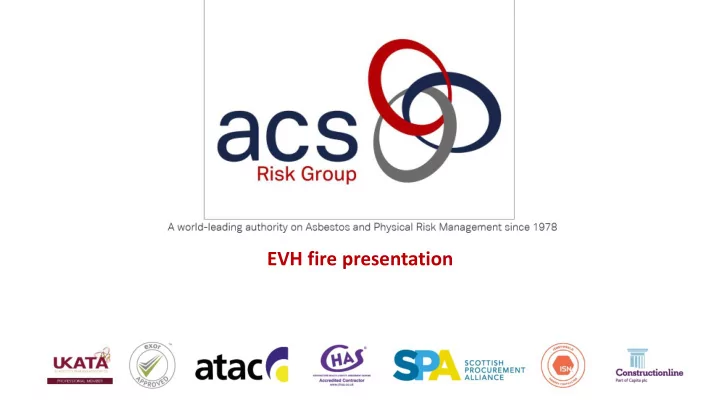

EVH fire presentation
The last year Grenfell 14 th June 2017 71 deaths
The last year Cameron House 18 th December 2017 2 deaths
The last year Victoria’s Nightclub, Sauchiehall Street 22 nd March 2018
General trends
Lakanal House 3 rd July 2009 6 deaths
Our current situation
Current legal requirements in Scotland The Fire (Scotland) Act on risk assessments Which locations need to be covered by a fire a fire risk assessment? Required: Not required: In any areas controlled by In common areas of residential businesses blocks In non-tenant areas of blocks In tenants’ flats (lofts, plant areas etc.) In HMOs
Current legal requirements in Scotland Regulations vs risk-based approach In some situations, a building may be constructed to the standards required by the building regulations, however a risk assessment may still identify points where ‘reasonably practicable’ adjustments can (and thus should) reduce risk.
Current legal requirements in Scotland The Housing Act: private vs. social landlords The far more onerous Repairing Standard, currently applies only to private landlords. Social landlords are only subject to the Tolerable Standard. The Scottish Government has now committed to extending the existing high standard required in private rented housing to all homes. The Housing (Scotland) Act 1987 will be amended to reflect the new requirements.
Current legal requirements in Scotland Competency of assessors There are currently no specified requirements to define competency to carry out fire risk assessments. In lieu of this, SKATE should be applied, with individuals able to identify all issues and people, and design reasonably practicable control measures. Skills Knowledge Attitude Training Experience
Current legal requirements in Scotland Competency of assessors Examples of issues FRAs may pick up on: • Blocked fire exits • Missing extinguishers • Excessive amounts of fuel / poor housekeeping • Uncontrolled ignition sources • Failed lighting • Poor signage
Current legal requirements in Scotland Competency of assessors Examples of issues FRAs may pick up on: • Hazards introduced by contractors • Compartmentation • Inadequate testing regimes • Training standards • Inner room procedures • Maximum occupancies • Structural issues, including cladding
Current legal requirements in Scotland The Hackitt Report Following the Grenfell fire and other issues with cladding on high rise buildings, the Department for Communities and Local Government asked Dame Judith Hackitt to conduct an independent review of building regulations and fire safety. In December last year, an interim report was published, with the final report due soon.
Current legal requirements in Scotland The Hackitt Report The findings of the interim report were that: • Current building regulations are too complex • The clarity of roles and responsibilities is poor • Methods of ensuring the competency of assessors are inadequate • There are a lack of meaningful sanctions following breaches
Where are the risks? Building regulations are primarily concerned with ‘visible’ fire protection measures. In most modern buildings, the risk to staff, members of the public, property and business continuity from fire is more closely related to the quality of fire risk management.
Fire risk management systems • Policies Plan • Roles and responsibilities • Risk assessment • Arrangements • Procedures Act Do • Training • Audits Check
Fire management systems Policies Although these can technically be a simple statement of intent, they should be tailored to the specific premises to which they apply. A policy for a small office would be unlikely to be suitable for a multi- storey building.
Fire management systems Roles and responsibilities These are the different areas and tasks relating to fire safety and who has responsibility for each should be clearly defined. The management system should also outline the duty of staff to cooperate with their employer, to identify and report hazards and not to misuse anything provided for their safety.
Fire management systems Arrangements / resources A list of equipment and processes designed to reduce the risk from fire. This might include information on: • Fire extinguishers • Any sprinkler or deluge systems • Planned maintenance regimes • Fire drills • Housekeeping checks • Any volatile materials on site • Any temporary measures in place
Fire management systems Procedures A description of the actions to take in certain circumstances, including in the event of a fire. These must be site specific, and should include: • The actions to take upon discovery of fire / hearing the alarm • The methods of evacuating any disabled persons present • When should fire extinguishers be used and by whom
Fire management systems Procedures Procedures for managing the day-to-day running of a premises with regard to fire safety should also be recorded. These might include: • Processes for controlling work carried out on site, such as hot works, or any procedures that may affect compartmentation. • Processes for identifying visitors and providing them with information.
Fire management systems Training By law, fire awareness training should be provided as part of induction. This should be refreshed on a regular basis, ideally annually. Training can be completed in a number of fashions: • Face-to-face training sessions • Toolbox talks • E-learning
Fire management systems Training Other types of fire-related training may also be necessary. These include: • Fire warden training • Fire extinguisher training • Evacuation of non-ambulant persons (evacuation chairs, mats coordinated lifts)
Fire management systems Audits As part of the ‘check’ aspect of ‘PDCA’, audits should be completed to identify issues and potential areas of improvement. These would include: • Identification of any updates to relevant law, ACoPs or guidance • Review of the fire risk assessment • Inspection of maintenance records • Inspection of training records
Fire management systems In summary • Fire safety is something that we can all do something about • Avoid complacency • Ensure that your fire management system is adequate • Take action to keep it that way
Recommend
More recommend